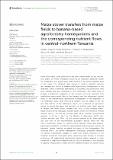| dc.description.abstract | Maize (Zea mays) stover produced in the drier lowland areas on the volcanic foot slopes of Mount Kilimanjaro serves as an important additional fodder for smallholder zero-grazed dairy cattle farming in the humid highland areas of the region. The obtained cattle manure is used to replenish nutrients and manage soil fertility in banana-based agroforestry homegardens of the highlands, which contributes significantly to sustaining crop production, thus food security and the livelihoods of the community. The study aims to provide a preliminary evaluation of the amounts of stover removed from smallholder maize-based fields in the lowlands and the subsequent nutrient flows to the banana-based agroforestry homegardens of the highlands. In 54 smallholder maize fields selected at random from 11 villages in the Hai and Siha districts of the Kilimanjaro region, we conducted an agronomic survey to record the types and amounts of fertilizer used, plant spacing at harvest, and maize stover biomass yield. Most of the surveyed maize-based fields received inadequate nutrient inputs, which were limited to mineral nitrogen alone if any. Of the surveyed fields, 16.7% received recommended amounts of 74 kg N ha–1 by the Ministry of Agriculture, 46.3% sub-optimal amounts and 37.0% did not receive fertilizer at all. Plant density was only 50% of the recommended population density. While this was only a preliminary study on nutrient flows between maize and banana-based agroecosystems, our findings demonstrated that potassium exports via harvested banana bunches exceeded the inputs in the homegardens. We conclude that (i) soil fertility management techniques, preferably integrated soil fertility management, suitable for small-scale maize production in the lowlands should be formulated while optimizing plant density to increase production, (ii) maize-based agroforestry farming system adapted to drier conditions to deal with windstorm and soil erosion problems in the lowlands is urgently needed, and (iii) wider and more detailed research on nutrient flows between maize and banana-based agroecosystems should be conducted to document their respective soil nutrient balances and the sustainability of such practice. | en_US |

